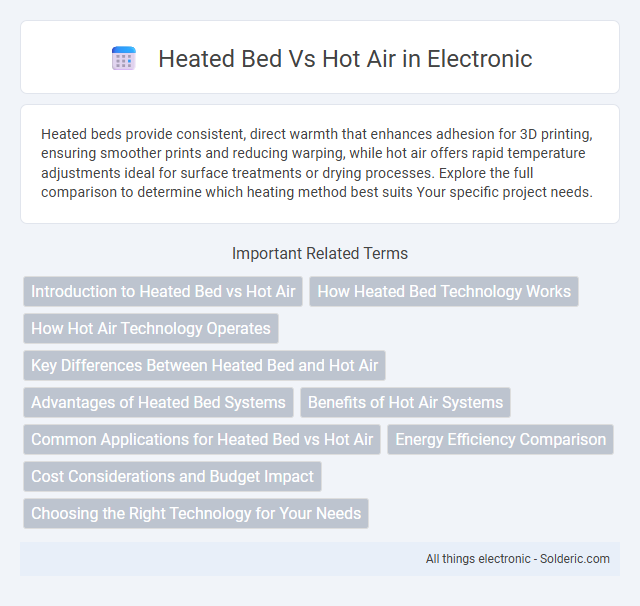Heated beds provide consistent, direct warmth that enhances adhesion for 3D printing, ensuring smoother prints and reducing warping, while hot air offers rapid temperature adjustments ideal for surface treatments or drying processes. Explore the full comparison to determine which heating method best suits Your specific project needs.
Comparison Table
| Feature | Heated Bed | Hot Air |
|---|---|---|
| Purpose | Maintains print surface temperature to prevent warping | Provides directed heat for drying, curing, or heating components |
| Heat Distribution | Even, uniform heat across entire print surface | Focused, localized heat on specific areas |
| Typical Temperature Range | 30degC to 120degC (86degF to 248degF) | Up to 600degC (1112degF) depending on device |
| Applications | 3D printing bed adhesion, ABS/PLA printing | Reflow soldering, paint drying, plastic welding |
| Energy Consumption | Moderate, consistent | Variable, often higher due to focused heating |
| Safety Considerations | Risk of burns if touched; generally safe with enclosure | High risk of burns and fire; requires careful handling |
Introduction to Heated Bed vs Hot Air
Heated beds provide consistent, even warmth ideal for 3D printing, ensuring strong adhesion and reducing warping during the printing process. Hot air systems deliver targeted heat by directing airflow to specific areas, which speeds up drying or curing but may cause uneven temperature distribution. Understanding the benefits and limitations of both heated beds and hot air can help optimize your 3D printing or manufacturing workflow.
How Heated Bed Technology Works
Heated bed technology in 3D printers utilizes an embedded resistor or silicone heater beneath the build surface, maintaining a consistent temperature to prevent warping and improve adhesion during printing. Temperature sensors, such as thermistors, continuously monitor and regulate the heat to ensure precision and stability throughout the print process. This even heat distribution enhances layer bonding and reduces material shrinkage, resulting in higher-quality prints.
How Hot Air Technology Operates
Hot air technology operates by circulating heated air uniformly around the print surface, ensuring consistent temperature distribution and reducing warping during 3D printing. Unlike traditional heated beds that directly warm the print platform, hot air systems use forced convection to maintain optimal thermal conditions without physical contact. This method enhances print adhesion and quality by evenly regulating temperature while minimizing energy consumption.
Key Differences Between Heated Bed and Hot Air
Heated beds provide consistent, direct surface heat to improve 3D print adhesion and reduce warping, while hot air uses circulated warm air to evenly heat the printing environment. Heated beds typically operate at temperatures ranging from 50degC to 110degC, enabling better layer bonding for materials like ABS and PLA, whereas hot air systems maintain ambient heat around the print without direct contact. The choice between heated beds and hot air depends on material requirements, energy efficiency, and the desired thermal management during the printing process.
Advantages of Heated Bed Systems
Heated bed systems provide uniform temperature distribution, significantly improving 3D print adhesion and reducing warping, especially with materials like ABS and PETG. These systems enhance the first layer's quality by maintaining optimal thermal conditions, which supports consistent layer bonding and overall structural integrity. Energy efficiency and precise temperature control make heated beds essential for high-precision additive manufacturing processes.
Benefits of Hot Air Systems
Hot air systems provide precise temperature control, ensuring consistent and even heat distribution across the entire printing surface. This improved thermal regulation reduces warping and enhances layer adhesion, resulting in higher print quality for complex or large 3D models. Unlike heated beds, hot air systems offer faster heating times and greater energy efficiency, optimizing printing speed and operational costs.
Common Applications for Heated Bed vs Hot Air
Heated beds are primarily used in 3D printing to prevent warping by maintaining consistent surface temperatures for materials like PLA, ABS, and PETG. Hot air technology finds common applications in soldering, rework, and drying processes where directed, high-temperature airflow is essential for precision and efficiency. Both technologies serve distinct roles in manufacturing and prototyping, with heated beds ensuring print adhesion and hot air enabling targeted thermal treatment.
Energy Efficiency Comparison
Heated beds typically offer higher energy efficiency for 3D printing by maintaining consistent temperatures with minimal heat loss, reducing overall power consumption. Hot air systems often consume more energy due to the continuous airflow needed to evenly distribute heat, leading to potential heat dissipation and inefficiency. Your choice should consider the specific printing requirements and energy costs to optimize performance and savings.
Cost Considerations and Budget Impact
Heated beds generally have a lower upfront cost compared to hot air systems, making them a budget-friendly option for 3D printing enthusiasts. Operating costs for heated beds remain minimal due to their efficient power consumption, whereas hot air systems can increase electricity expenses because of prolonged heating cycles. For cost-conscious users, investing in a heated bed offers greater economic sustainability without sacrificing print quality in most applications.
Choosing the Right Technology for Your Needs
Heated beds offer consistent and uniform heat distribution, making them ideal for printing materials like ABS and PETG that require steady warmth to prevent warping. Hot air systems excel in rapid temperature changes and localized heating, suitable for applications needing quick cooldowns or targeted heat control. Evaluating material compatibility, print size, and thermal requirements is essential for selecting the technology that best aligns with your 3D printing needs.
Heated bed vs hot air Infographic

 solderic.com
solderic.com